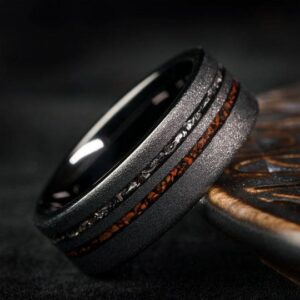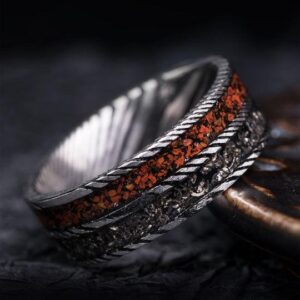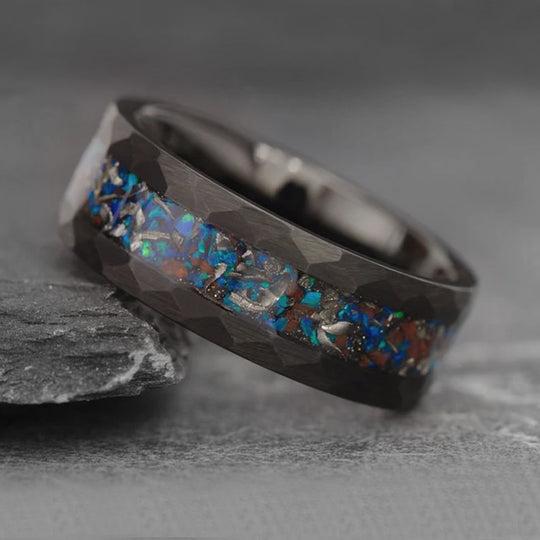Fossil wedding bands represent a fascinating intersection of ancient history and modern romance, capturing the imagination of couples seeking something truly distinctive for their special day. These remarkable pieces of jewelry incorporate genuine prehistoric materials, transforming remnants from millions of years ago into symbols of eternal commitment. As more couples move away from conventional diamond rings, fossil wedding bands have emerged as a compelling alternative that tells a story spanning eons.
The appeal of these bands extends beyond their striking appearance. Each ring carries within it a tangible connection to Earth’s distant past, making every piece inherently one-of-a-kind. This historical dimension adds profound meaning to wedding traditions, allowing couples to celebrate their union with jewelry that has witnessed the passage of geological time itself.
Beyond their symbolic value, fossil wedding bands offer practical advantages that modern couples appreciate. The materials used in these rings, when properly prepared and set, provide excellent durability for everyday wear. Combined with careful craftsmanship that ensures comfortable fit, these bands prove that choosing something unconventional doesn’t mean sacrificing quality or wearability.
Why Fossil Wedding Bands?
The materials embedded in fossil wedding bands carry stories that stretch back millions of years, connecting wearers to epochs when dinosaurs roamed the earth or ancient marine creatures dominated prehistoric seas. Dinosaur bone fragments, for instance, have undergone a remarkable transformation through mineralization, where original organic material has been replaced by silica and other minerals over countless millennia. This process creates stunning patterns and colors unique to each specimen, ranging from rich reds and browns to striking blacks and grays. The geological journey these materials have undertaken adds a dimension of wonder that no manufactured stone can replicate.

Incorporating these ancient elements into wedding jewelry transforms a personal commitment into something that transcends human timescales. While traditional rings symbolize eternal love through their circular form, fossil bands add physical evidence of endurance through deep time. This tangible connection to natural history resonates particularly with couples who appreciate paleontology, geology, or simply want their jewelry to reflect their intellectual curiosity about the world.
The surge in natural history-themed jewelry reflects broader cultural shifts toward personalization and meaningful consumption. Museums report record attendance, documentary series about prehistoric life capture massive audiences, and collectors eagerly seek authentic specimens. This enthusiasm has naturally extended to jewelry design, where artisans have discovered ways to ethically source and beautifully showcase fossilized materials. Couples increasingly view their wedding bands as expressions of their personalities and interests rather than adherence to conventional expectations, making fossil rings a perfect choice for those who value both aesthetic beauty and substantive meaning in their most cherished possessions.
Designing with Fossil Wedding Bands
Creating a fossil wedding band begins with careful selection of the prehistoric material that will form the ring’s centerpiece. Artisans typically work with fossilized dinosaur bone, ancient wood, or mineralized marine creatures, each offering distinct visual characteristics. The chosen fossil must be stable enough for jewelry use, which means it has undergone complete mineralization where organic matter has been entirely replaced by stone. Craftspeople examine each specimen for structural integrity, color patterns, and visual interest before cutting it into inlay-ready pieces. This initial assessment determines how the fossil will be oriented within the band to showcase its most captivating features, whether that’s the cellular structure of dinosaur bone or the growth rings of petrified wood.
The actual construction involves precision metalwork combined with delicate fossil handling. Most designs feature a metal band—commonly tungsten, titanium, or precious metals—with a channel carved to receive the fossil inlay. The fossil material is carefully shaped to fit this channel perfectly, then secured using specialized adhesives that can withstand daily wear while remaining invisible. Some artisans incorporate protective resin coatings over the fossil to enhance durability and bring out the material’s natural colors. The metal choice significantly impacts the ring’s final character; darker metals like black zirconium create dramatic contrast with lighter fossils, while rose gold complements the warm tones found in many dinosaur bone wedding band specimens.

Customization possibilities extend far beyond simple material selection. Couples can choose the width of their bands, the proportion of fossil to metal, and even the specific fossil type that resonates with their personal story. Some opt for matching bands cut from the same fossil specimen, ensuring their rings share an identical prehistoric origin. Others prefer complementary designs where one partner’s ring features dinosaur bone while the other showcases meteorite or another ancient material. Engraving options allow for hidden messages on the interior, and some jewelers offer mixed inlays that combine fossil with other natural materials like turquoise or opal. This flexibility ensures that each couple can create rings that genuinely reflect their unique relationship while maintaining the ancient essence that makes fossil bands so compelling.
Durability and Comfort
Fossilized materials used in wedding bands have spent millions of years undergoing mineralization, a process that transforms organic matter into stone-like substances with remarkable hardness. Dinosaur bone, for example, achieves a hardness rating between 5 and 7 on the Mohs scale after complete fossilization, making it comparable to many gemstones used in traditional jewelry. This mineral composition means the fossil inlay resists scratching from everyday activities and maintains its appearance through years of wear. When properly sealed and set within a protective metal channel, these ancient materials prove surprisingly resilient against the bumps and impacts that wedding bands inevitably encounter.
The comfort level of fossil wedding bands matches or exceeds traditional ring designs when crafted by experienced jewelers. The inlay technique keeps the fossil flush with the metal surface, creating a smooth profile without protruding elements that might catch on clothing or feel awkward during hand movements. Most designs feature gently rounded interior surfaces known as comfort-fit profiles, which distribute pressure evenly around the finger and allow the ring to slide on easily while staying securely in place. The combination of smooth fossil inlay and thoughtful metal shaping results in rings that wearers often forget they’re wearing, the hallmark of truly comfortable jewelry.
Weight concerns often arise when couples first consider fossil bands, particularly those featuring dense metals like tungsten or platinum. However, the actual wearing experience typically surprises people pleasantly. While these rings may feel slightly heavier than thin gold bands when first held, the weight becomes imperceptible within days as wearers adjust. The fossil inlay itself adds minimal mass since it occupies space that would otherwise be filled with metal. For those genuinely concerned about weight, titanium-based designs offer exceptional lightness without sacrificing durability, and narrower band widths reduce overall mass while maintaining structural integrity and visual impact.
Popularity and Trends
The wedding jewelry market has witnessed a remarkable shift toward alternative materials over the past decade, with fossil wedding bands positioned at the forefront of this movement. Social media platforms showcase countless couples proudly displaying their unconventional rings, generating engagement that traditional jewelry rarely achieves. This visibility has created a ripple effect, where each shared image inspires others to explore beyond conventional options. Celebrity endorsements have further amplified this trend, with several high-profile figures choosing fossil or meteorite bands for their own ceremonies. The result is a democratization of unique jewelry choices, where what was once considered niche has become increasingly mainstream and accessible to couples across various demographics.
Wedding traditions themselves are evolving to accommodate more personalized expressions of commitment, and fossil bands align perfectly with this cultural transformation. Modern couples increasingly prioritize authenticity and storytelling over adherence to established customs. They seek wedding elements that reflect their shared interests, whether that’s a passion for science, appreciation for natural history, or simply a desire to own something genuinely distinctive. This shift extends beyond jewelry to encompass all aspects of wedding planning, from venue selection to ceremony structure. Fossil wedding bands serve as tangible representations of this broader movement, allowing couples to honor tradition through the act of exchanging rings while simultaneously breaking from conventional aesthetic expectations.
The environmental consciousness driving many consumer decisions has found expression in fossil wedding band selection, though the sustainability narrative requires nuanced understanding. Fossil materials represent a form of natural recycling, where ancient organic matter has been preserved and transformed over geological time. No new mining or extraction is required specifically for these materials, as they’re recovered from existing paleontological sites or sourced from specimens already in circulation. This appeals to environmentally minded couples who appreciate that their rings don’t contribute to additional environmental disruption. However, responsible sourcing remains crucial, as fossils should come from legal, ethical sources that respect both paleontological science and land rights. When properly sourced, these bands offer a way to celebrate Earth’s history while minimizing ecological impact, making them attractive to couples who want their wedding choices to reflect their values regarding sustainability and environmental stewardship.
Choosing the Right Fossil Wedding Bands
Selecting fossil wedding bands requires attention to several key factors that ensure you receive authentic, high-quality pieces worthy of daily wear. Begin by researching jewelers who specialize in alternative materials and can demonstrate expertise with fossil inlays. Companies like Saga Bands have built reputations around crafting unique rings that incorporate prehistoric materials alongside other distinctive inlay options. Request detailed information about the fossil’s origin, including the geological formation and approximate age. Reputable sellers provide certificates of authenticity or documentation tracing the material’s provenance. Examine the craftsmanship closely—the fossil should sit flush within the metal channel without gaps, and any protective coating should appear clear and even. Ask about the specific type of fossil used, as different materials offer varying patterns and durability characteristics. Request to see multiple examples if possible, since fossil patterns vary dramatically even within the same specimen type. Consider how the ring’s width and profile feel on your finger during an extended trial period, and verify that the jeweler offers sizing services or exchanges if needed.
Authenticity verification protects against purchasing composite materials or artificially enhanced specimens misrepresented as genuine fossils. Legitimate fossil inlays display natural irregularities and organic patterns that synthetic materials cannot perfectly replicate. Under magnification, genuine fossilized bone reveals cellular structures and mineralization patterns consistent with geological processes. Be cautious of prices that seem unusually low, as authentic prehistoric materials command fair market values reflecting their rarity and the skill required to prepare them for jewelry use. Quality craftsmanship shows in the details—smooth edges, secure settings, and finishes that enhance rather than obscure the fossil’s natural beauty. A well-made fossil band should feel substantial without being cumbersome, and the metal components should show consistent thickness and professional finishing throughout.
Ethical sourcing considerations matter significantly when purchasing fossil jewelry. Fossils should come from legal excavations on private land with proper permissions, or from specimens already in commercial circulation through legitimate channels. Avoid rings containing materials from protected paleontological sites or countries with strict fossil export restrictions. Responsible jewelers can explain their sourcing practices and demonstrate compliance with relevant regulations. Consider the scientific value of the materials—while small bone fragments and common fossilized wood are appropriate for jewelry, rare or scientifically significant specimens belong in research collections and museums. Some artisans partner with paleontological organizations, ensuring their materials come from ethical sources while supporting scientific work. By choosing vendors committed to responsible practices, you ensure your wedding bands celebrate natural history without compromising paleontological heritage or contributing to illegal fossil trade.
Embrace Ancient History in Your Wedding Bands
Fossil wedding bands offer couples an extraordinary opportunity to blend ancient natural history with contemporary commitment, creating jewelry that transcends conventional symbolism. These remarkable rings incorporate genuine prehistoric materials that have journeyed through millions of years of geological transformation, resulting in pieces that are both visually stunning and profoundly meaningful. The durability of properly mineralized fossils, combined with expert craftsmanship and protective metal settings, ensures these bands withstand the demands of daily wear while maintaining their distinctive appearance.
The practical benefits extend beyond aesthetics and symbolism. Fossil wedding bands provide exceptional comfort through thoughtful design features like flush inlays and comfort-fit profiles, while their unique patterns guarantee that no two rings are identical. The growing popularity of these alternative materials reflects broader cultural shifts toward personalization, authenticity, and meaningful consumption in wedding traditions. For environmentally conscious couples, the use of naturally preserved materials offers an appealing alternative to newly mined resources.
If you’re seeking wedding bands that tell a story spanning geological epochs while reflecting your individuality, fossil rings deserve serious consideration. By choosing reputable jewelers committed to ethical sourcing and quality craftsmanship, you can acquire authentic pieces that honor both your relationship and Earth’s remarkable history. These distinctive bands transform the traditional exchange of rings into something truly extraordinary—a celebration of love anchored in the enduring beauty of our planet’s ancient past.







